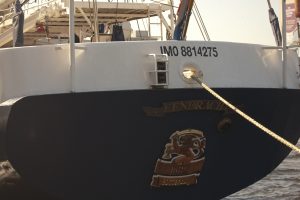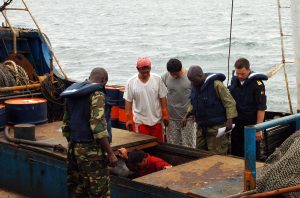Five Ways to Fight Illegal Fishing
By Lindsay Jennings, RJD Intern
The issue of illegal fishing has, deservedly, been getting international attention recently but it should be noted that this ‘great ocean heist’ is not a new phenomenon. For far too long fishing boats have been misreporting or underreporting their catches. There simply are not enough fish for these boats to catch so they resort to illegal, unreported and unregulated (IUU) fishing. IUU fishing accounts for $10-$23 billion annually in internationally traded seafood,[1] and to compound the problem, it has been linked to environmental degradation, political instability, slave labor, and the movement of other illicit cargo like drugs and weapons. While there is not one single solution, there can be a complimenting set of actions taken at international, national, and local levels to address this threat, of which the top five are presented below:
- Legislation – It is crucial to develop the framework for addressing IUU fishing on a global scale, as this kind of fishing is rarely confined by species or geographic boundaries. Legislation like the Port States Measures Agreement (PSMA) gives countries the opportunity to reduce profitability of IUU fishing by denying port access and services to IUU vessels, better controlling what seafood is coming into their ports.[2] Combined international efforts to pass and implement this global treaty would allow some of the world’s largest and most lucrative ports to not only penalize those who illegally fish but close the market for vessels trying to offload their catch.
- Global Vessel Identification – Although the right to fish on the high seas is given to all countries, some are unwilling or unable to enforce their regulations, providing illegal fishermen with ‘flags of convenience.’ When IUU vessels are compromised, crews will often re-flag, or re-register, their vessels to a different port state, evading law enforcement and circumventing international fishing regulations.[3] Similar to a car’s Vehicle Identification Number (VIN) or our Social Security Numbers, Unique Vessel Identifiers (UVI) can be used to ‘tag’ a fishing vessel with a non-transferable, unique number which stays with that vessel until it is permanently taken out of the water. By eliminating the ability for vessels to hide behind a new identity, punishments for illegal fishing activities would dramatically increase.3

Unique and permanent vessel identification numbers can help cut down IUU vessels from re-flagging themselves. Credit: Wikimedia Commons
- Seafood Traceability – The United States is the second largest importer of seafood,[4] a commodity which earns more in annual trading than coffee, cocoa, bananas, and rubber combined. With the majority of seafood caught out of sight of authorities, it is essential to ensure that what is being caught and sold is done so legally. Traceability programs would require imports to be accompanied with documentation describing vessel, date, location, gear, species, and common name, to ensure traceability from bait to plate.[5] Seafood retailers have the ability to influence consumer behaviors and demand for legal seafood. They can shift the risk to reward ratio of IUU fishing by eliminating market access for illegal seafood, stopping it from ‘paying off.’[6]
- Monitoring, Surveillance, and Compliance (MSC) – While legislation and regulations offer a sound framework, they become ineffective if vessels are not complying with those regulations.[7] Enforcement is often lacking or nonexistent on the high seas, therefore MSC systems must be implemented to ensure adequate monitoring and surveillance. The simple use of technology like vessel monitoring systems (VMS) and automatic identification systems (AIS) would guarantee vessels are fishing within legal limits. Beyond VMS and AIS, satellite monitoring and even remote operated drones have proven to be effective,6 allowing authorities to watch fishing effort from 1000’s of miles away and adding a much-needed layer of accountability.

Portuguese Navy and Gabonese sailors work together to inspect a holding bay for fish aboard an IUU fishing vessel. Credit: U.S. Navy
- Development – IUU fishing often stems from developing country’s underlying social, economic, and political issues, meaning they have greater difficulties achieving enforcement and compliance.7 With the primary motivation for IUU fishing being financial gain, coupled with poor economic prospects, incentive will remain to engage in this kind of fishing until alternative jobs pay a higher wage.3,7 Governments and non-governmental organizations should cooperate to develop alternative sources of employment to disincentivize IUU fishing without sacrificing the ability of those fishers to support themselves.

The Coast Guard Cutter, Rush, escorts a high seas illegal fishing vessel back to port. Credit: U.S. Coast Guard
IUU fishing is one of the most serious threats facing the achievement of sustainable global fisheries and food security. Fortunately, the tools to fight IUU fishing already exist. The responsibility doesn’t lie with one country, but with a strong and coordinated effort of international and national players who can effectively deter fishers from engaging in and benefitting from IUU fishing.
[1] Agnew, David J., John Pearce, Ganapathiraju Pramod, Tom Peatman, Reg Watson, John R. Beddington, and Tony J. Pitcher. “Estimating the worldwide extent of illegal fishing.” PLoS One 4, no. 2 (2009): e4570.
[2] Flothmann, Stefan, Kristín von Kistowski, Emily Dolan, Elsa Lee, Frank Meere, and Gunnar Album. “Closing loopholes: getting illegal fishing under control.” Science 328, no. 5983 (2010): 1235-1236.
[3] Gallic, Bertrand Le, and Anthony Cox. “An economic analysis of illegal, unreported and unregulated (IUU) fishing: Key drivers and possible solutions.” Marine Policy 30, no. 6 (2006): 689-695.
[4] NOAA. 2012. Fisheries of the United States 2011. National Marine Fisheries Service and the Office of Science and Technology. Available via: http://www.st.nmfs.noaa.gov/st1/fus/fus11/FUS_2011.pdf.
[5] Borit, Melania, and Petter Olsen. “Evaluation framework for regulatory requirements related to data recording and traceability designed to prevent illegal, unreported and unregulated fishing.” Marine Policy 36, no. 1 (2012): 96-102.
[6] Global Ocean Commission. “Illegal, unreported, and unregulated fishing.” (2013). Available via: http://www.globaloceancommission.org/wp-content/uploads/GOC-paper08-IUU-fishing.pdf
[7] Erceg, Diane. “Deterring IUU fishing through state control over nationals.” Marine Policy 30, no. 2 (2006): 173-179.
